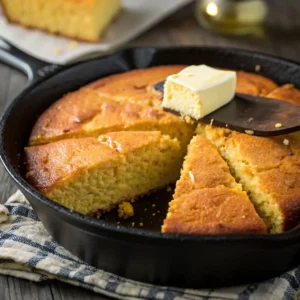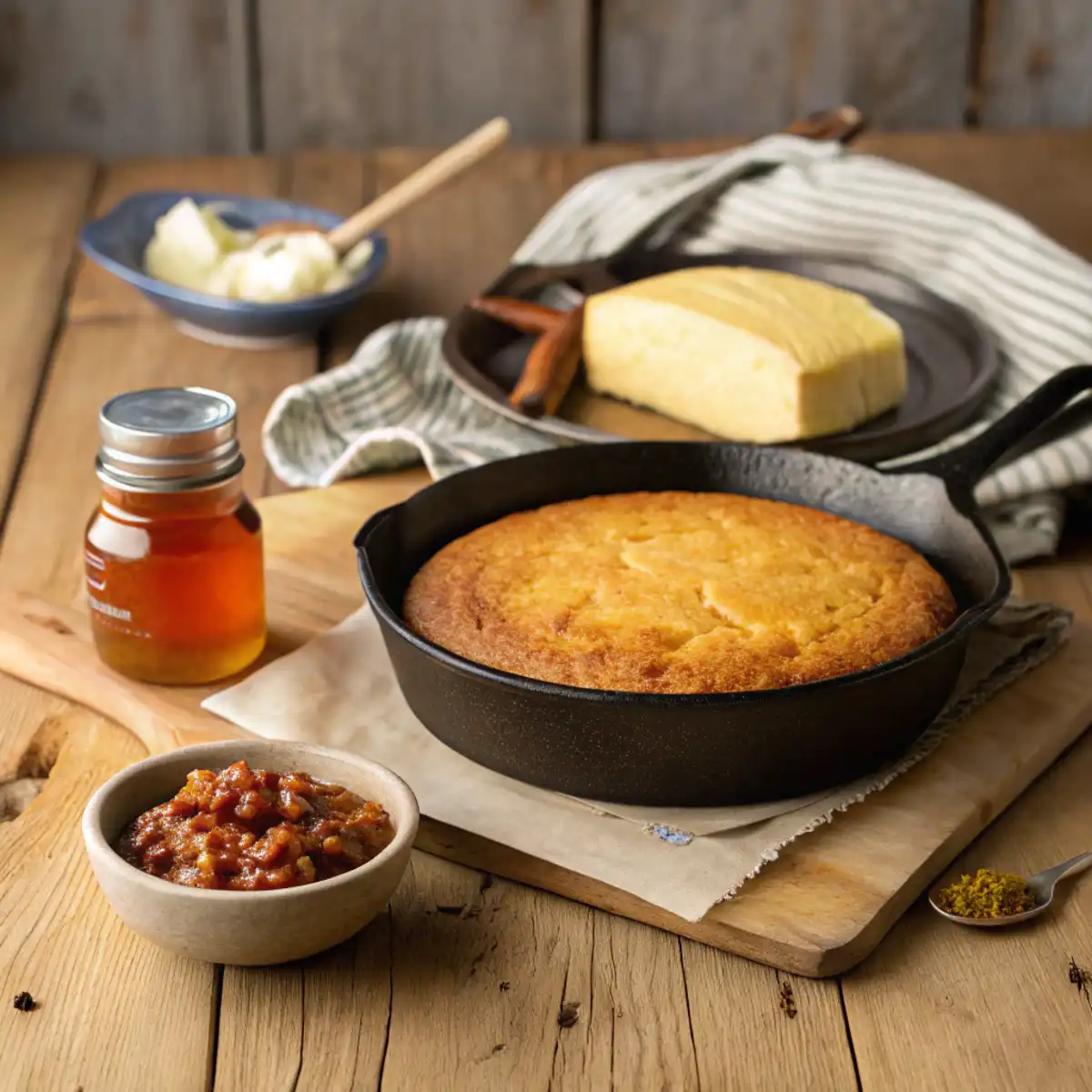Cornbread is a timeless Southern staple that has made its way into kitchens across the world. Among its many variations, cast iron skillet cornbread stands out as a recipe steeped in tradition and brimming with flavor. This article dives deep into everything you need to know about this comforting dish—from its history and ingredients to tips for achieving the perfect bake. Let’s embark on a culinary journey that celebrates the rich legacy of cast iron cooking and the irresistibly crispy edges of skillet-baked cornbread.
Introduction to Cast Iron Skillet Cornbread
What is Cast Iron Skillet Cornbread?
Cast iron skillet cornbread is a savory or slightly sweet bread made with cornmeal and baked to perfection in a hot, well-seasoned cast iron skillet. Unlike other baking methods, the skillet creates a unique combination of a crisp, golden crust and a tender, moist interior. The result? A rustic, flavorful bread that pairs beautifully with nearly any meal.
Historical Significance and Regional Variations
Cornbread has deep roots in Native American and Southern culinary traditions. Early recipes were simple, relying on ground cornmeal, water, and salt. Over time, buttermilk, baking powder, and eggs were introduced, evolving the recipe into the fluffy yet hearty bread we know today. Across the U.S., variations abound—Northern versions lean sweeter, while Southern recipes stay true to their savory origins.
Why Use a Cast Iron Skillet for Cornbread?
The cast iron skillet isn’t just an old-fashioned tool; it’s a secret weapon for flavor and texture. Thanks to its even heat distribution, the skillet ensures a consistent bake, while its ability to retain heat creates the iconic crispy edges that elevate the dish. Additionally, the nonstick properties of a seasoned skillet make it perfect for this batter, which can stick to other types of pans.
In summary, cast iron skillet cornbread is more than a recipe—it’s a tradition that brings people together, offering a taste of history with every bite. Ready to learn the secrets of perfect cornbread? Let’s dig in!
Ingredients Breakdown
Core Ingredients: Cornmeal, Buttermilk, and More
The foundation of cast iron skillet cornbread lies in its ingredients. Cornmeal, the star of the dish, brings a grainy texture and nutty flavor. Opt for coarsely ground cornmeal for a traditional feel or finer grains for a smoother texture. Buttermilk is another essential component, offering a tangy depth that enhances the bread’s moistness. Together with flour, baking powder, and baking soda, these elements create the perfect balance of fluffiness and structure.
Other staples include eggs for binding and richness, unsalted butter for flavor, and a touch of sugar (if preferred) to balance the savory notes. Always use fresh, high-quality ingredients for the best results.
Optional Add-ins for Flavors and Textures
Looking to spice things up? Add diced jalapeños for a fiery kick, shredded cheddar for a cheesy twist, or honey for a sweet touch. Herbs like rosemary or thyme can lend an earthy aroma, while corn kernels add bursts of sweetness. Don’t hesitate to experiment!
Importance of Quality Ingredients
Quality matters. For instance, using freshly milled cornmeal or organic buttermilk can elevate the dish’s taste. If possible, stick to natural or minimally processed ingredients to stay true to the rustic essence of cast iron skillet cornbread.
Tools and Equipment for Perfect Cornbread
Essential Tools: Cast Iron Skillet
A well-seasoned cast iron skillet is non-negotiable for authentic cast iron skillet cornbread. Its ability to distribute heat evenly ensures a uniform bake, while its retention of high heat creates the coveted crispy crust. A 9- or 10-inch skillet is ideal for most recipes, accommodating the batter without overflowing.
Additional Equipment to Enhance the Process
Other helpful tools include a whisk for combining the dry and wet ingredients without lumps, a silicone spatula for scraping the bowl, and an oven mitt for safely handling the hot skillet. If you’re prepping ahead, a mixing bowl with a pour spout can make transferring the batter mess-free.
Maintaining and Preparing Your Cast Iron Skillet
To prevent sticking and ensure even baking, properly season your skillet before use. Coat it lightly with oil, heat it in the oven, and allow it to cool. This process builds a natural nonstick layer and enhances the skillet’s longevity. Taking care of your tools is key to making flawless cast iron skillet cornbread every time!
Step-by-Step Recipe Guide
Preparing the Ingredients and Skillet
Before you dive into making cast iron skillet cornbread, gather all your ingredients and tools. Preheat your oven to 425°F and place your skillet inside to heat up. This ensures the batter starts cooking the moment it touches the pan, creating that irresistible crispy crust. While the skillet heats, combine your dry ingredients—cornmeal, flour, baking powder, and baking soda—in a large bowl. In another bowl, whisk together the wet ingredients: buttermilk, eggs, and melted butter.
Mixing the Batter: Tips for Consistency
Gradually add the wet ingredients to the dry ones, stirring just until combined. Overmixing can lead to dense cornbread, so stop when there are no visible dry streaks. If you’re adding extras like cheese, corn, or jalapeños, gently fold them in now. Let the batter rest for about 10 minutes to allow the cornmeal to absorb the liquid, enhancing the texture.
Baking to Perfection: Temperature and Timing
Carefully remove the hot skillet from the oven and coat it with a thin layer of melted butter or oil to prevent sticking. Pour the batter into the sizzling skillet and smooth the top. Reduce the oven temperature to 375°F and bake for 20–25 minutes, or until a toothpick inserted in the center comes out clean. Keep an eye on it to avoid overbaking, as a dry cornbread is nobody’s favorite.
Serving and Storing Your Cornbread
Once baked, let your cast iron skillet cornbread cool for about 10 minutes before slicing. Serve it warm with butter, honey, or alongside hearty dishes like chili or fried chicken. Leftovers can be wrapped tightly and stored at room temperature for two days or refrigerated for up to a week.
For more insights into the differences between cornbread variations, check out our article Difference Between Cornbread and Southern Cornbread.

Variations and Creative Twists
Adding Sweetness or Heat: Honey, Jalapeños, and More
Want to put a spin on your cast iron skillet cornbread? Add a tablespoon of honey or maple syrup to the batter for a subtle sweetness. For those who love a bit of heat, finely chopped jalapeños or a sprinkle of cayenne can give your cornbread a spicy kick. Craving something indulgent? Fold in shredded cheddar or crumbled bacon for a savory delight.
Gluten-Free or Vegan Adjustments
Dietary restrictions don’t have to stop you from enjoying this classic dish. Swap regular flour with gluten-free alternatives like almond or rice flour. For a vegan version, use plant-based milk and a flaxseed or chia seed substitute for eggs. Coconut oil or vegan butter can replace regular butter seamlessly.
Pairing Cornbread with Meals: Southern Staples and Beyond
Cast iron skillet cornbread is incredibly versatile. Serve it with classic Southern dishes like barbecue ribs or collard greens, or enjoy it as a side to soups and stews. It’s also fantastic on its own, paired with honey butter for a cozy snack.
For more recipe ideas, check out our Savory Bread Pudding Recipe for another comforting dish!
Common Mistakes and How to Avoid Them
Overmixing or Undermixing Batter
One of the most common mistakes when making cast iron skillet cornbread is overmixing the batter. While it’s tempting to aim for a silky-smooth consistency, too much mixing activates the gluten in the flour, resulting in a dense or rubbery texture. Instead, mix just until the ingredients are combined, even if there are a few lumps. On the flip side, undermixing can leave pockets of dry flour, so aim for balance.
Improper Skillet Use or Maintenance
A cast iron skillet is key to achieving that crispy crust, but improper use can ruin your cornbread. Always preheat your skillet before adding the batter—this step is crucial for creating the perfect crust. Additionally, ensure your skillet is well-seasoned to prevent sticking and enhance flavor. Avoid using soap when cleaning your skillet, as it can strip away the seasoning. Instead, clean it with hot water and a gentle scrubber, then dry it thoroughly to prevent rust.
Troubleshooting Texture or Flavor Issues
If your cornbread is too dry, try adding an extra splash of buttermilk or reducing the baking time. For bland cornbread, don’t shy away from adding more salt, sugar, or flavorful add-ins like cheddar or jalapeños. A few tweaks can turn an average cast iron skillet cornbread into a memorable dish.
FAQs About Cast Iron Skillet Cornbread
Can I Make Cornbread Without a Cast Iron Skillet?
Yes, you can! While a cast iron skillet offers the best results, other options like an oven-safe stainless steel pan or a glass baking dish can work. However, keep in mind that these alternatives won’t deliver the same crispy edges that make cast iron skillet cornbread so unique. To mimic the effect, preheat the pan in the oven before adding the batter.
How Do I Prevent Cornbread from Sticking?
To prevent sticking, ensure your cast iron skillet is properly seasoned. Before pouring in the batter, coat the skillet with a thin layer of melted butter or oil. This not only prevents sticking but also enhances the flavor. If using a different type of pan, line it with parchment paper or grease it generously.
What Are the Best Toppings for Cornbread?
Cast iron skillet cornbread is versatile and pairs well with both sweet and savory toppings. For a traditional touch, try butter and honey or maple syrup. If you prefer savory flavors, spread on some jalapeño cream cheese or a drizzle of chili oil. Cornbread also tastes amazing with a dollop of sour cream or crumbled bacon.
Conclusion and Final Thoughts
Why Cast Iron Skillet Cornbread is Worth the Effort
Whether you’re a seasoned baker or a beginner in the kitchen, cast iron skillet cornbread is a recipe worth mastering. The combination of its crispy edges, tender crumb, and rich flavor makes it a comforting dish that fits nearly any occasion. With its simple ingredients and timeless preparation, this bread carries a sense of tradition and warmth that’s hard to beat.
Bringing It All Together
By now, you know how to select the right ingredients, prepare your skillet, and troubleshoot common issues. You’ve explored creative variations and discovered the best ways to enjoy this classic dish. Armed with this knowledge, you’re ready to make your own version of cast iron skillet cornbread and wow your family and friends.
For more recipes that bring comfort and joy to your table, check out our article on Savory Bread Pudding Recipe. From Southern classics to innovative twists, there’s always something new to try. Happy baking!

